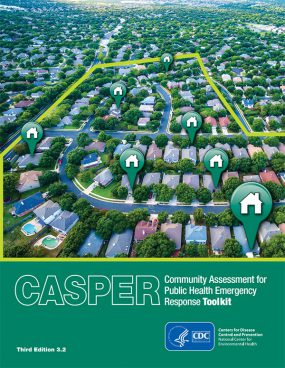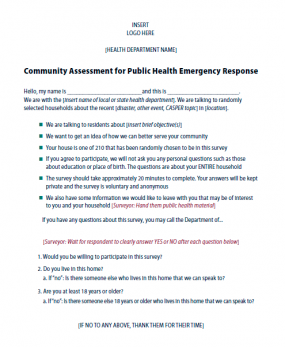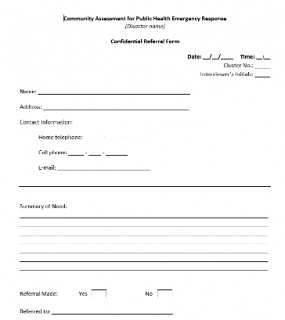CASPER Field Materials

CASPER Toolkit
CDC developed the CASPER Toolkit pdf icon[PDF – 23 MB] to assist personnel from any federal, state, tribal, local, or territorial (STLT) agencies or partners in conducting CASPER. The CASPER toolkit provides a step-by-step guide on sample selection, questionnaire development, training, data collection, analysis, and report writing as well as examples and templates of forms.
A presentation template for just-in-time training ppt icon[PPT – 10 MB] (508 Compliant PDF version pdf icon[PDF – 2 MB]) is available.
Consent Script
When interview teams arrive at a household, they should be prepared to give an introduction and obtain consent.
- Survey participants must give explicit verbal consent to participate in the CASPER interview.
- The interview may be conducted to one person or multiple people within the household as all questions are household level. It is helpful to have a script written for the interviewers to recite. See example CASPER consent script pdf icon[PDF – 23 MB].
- Interviewers who are concerned about memorizing all the information or about being rejected because of its length should begin with a brief introduction to receive initial agreement, then ask to read the full formal consent.
More information on a CASPER consent script is available in the CASPER Toolkit, Section 2.6.1 pdf icon[PDF 23 MB].
Questionnaire
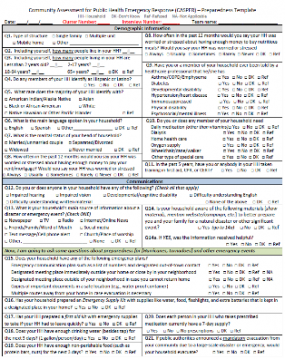
CASPER Preparedness Templatepdf icon for disaster planning.
All CASPER questions are asked at the household level. All questions should be related to an action. Always consider how data will be analyzed to help determine what variables are needed and thus, what questions should be included. CDC has multiple resources for CASPER questionnaire development:
- Preparedness Template pdf icon[PDF 210 KB] for disaster planning
- CASPER Drought pdf icon[PDF 192 KB]
- CASPER Hurricanes pdf icon[PDF 207 KB]
- CASPER Zika pdf icon[PDF 214 KB]
- Tips for Developing CASPER Questionnaires pdf icon
- Examples within the Disaster Epidemiology Community of Practice (DECoP) [Instructions for Joining the DECoPword icon]
CDC has multiple questionnaires from previous CASPERs available, including some EpiInfo databases. Please contact Amy Helene Schnall (GHU5@cdc.gov; CASPER@cdc.gov) for more information. A limited number of questionnaires are available online. You may access them through the NIH Disaster Research Response Project (DR2) external icon search term “CASPER” or by clicking on the links provided from the Interactive Map of CASPERs.
More information on questionnaire development, including general guidance, question categories, and weighing data collection options, is available in the CASPER Toolkit, Section 2.6.2pdf icon.
Tracking Form
The Tracking Form pdf icon[PDF 172 KB] is used to monitor the outcome of every interview attempt and is the basis for calculating the response rates (completion, contact, and cooperation). It is important to track every household selected, even those that are inaccessible. Print the tracking form on bright colored paper to remind interview teams of its importance and encourage completion.
More information on a CASPER tracking form is available in the CASPER Toolkit, Section 3.5pdf icon.
Confidential Referral Form
Field interview teams must be prepared to respond if they come across an urgent need. Typically, teams that encounter a household with urgent needs should encourage or assist the household to call emergency services (911). In the event that calling 911 is not appropriate, the teams should complete a confidential referral formword icon. This form is then communicated to the CASPER headquarters for triage and/or follow-up. Teams should not promise any action other than a general timeframe for response (e.g., 72 hours) from the health department.
More information on CASPER confidential referral forms is available in the CASPER Toolkit, Section 3.7pdf icon.
Epi Info 7 TM
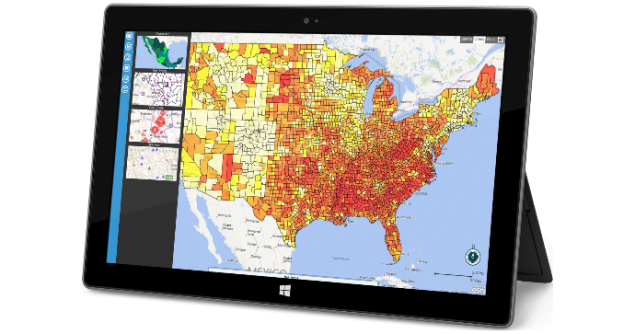
Epi Info 7TM is the recommended statistical package for entering and analyzing CASPER data. Epi Info 7TM is free, user-friendly, and can be downloaded on any computer (including those with administrative restrictions). There are multiple sources and guidance documents for using Epi Info ™ including the following:
- Tips for CASPER Questionnaire Development pdf icon[PDF – 3.39 KB]
- Tips for Template Use
- Epi InfoTM 7 User Guide pdf icon[PDF – 5.6 MB]
- Epi Info 7TM Tutorials
Specific Epi InfoTM templates for CASPER are available for download on the Disaster Epidemiology Community of Practice (DECoP) SharePoint site (instructions to request access to the DECoP are hereword icon) or by contacting CASPER@cdc.gov. For more information on developing a database and data cleaning, please see Appendix L & M pdf icon[PDF 23 MB]
NCEH provides technical assistance remotely and in field (by request and availability). If you would like assistance in conducting a CASPER, please visit the CDC Disaster Training and Response webpage or email Amy Helene Schnall at GHU5@cdc.gov
